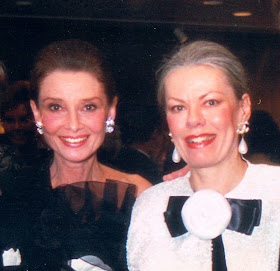 |
| Tree ball gown, Charles James, 1955, Metropolitan Museum of Art |
About a month ago, I spent the afternoon alone in museum rooms with Charles James, Schiaparelli, Givenchy, Coco Chanel, Dior, Jeanne Lanvin and other European and American history-making fashion designers. I was invited to attend the press preview for
High Style: Twentieth-Century Masterworks from the Brooklyn Museum Costume Collection at the
Legion of Honor in San Francisco. It was a little bit of heaven.
One of my main fashion heros,
Harold Koda, was there with the curator and author of the show catalog,
Jan Glier Reeder to take us through the exhibit. They are both so modest, knowledgeable and somewhat dishy about fashion history, I would love to spend the day with them just listening to stories. When the Met formed a partnership with the Brooklyn Museum in 2009, it was Jan's job to examine and photograph every fashion item. What a dream job!
After the tour, everyone left and I stayed with the exhibit. It was just me, the clothes and the patient security guards. Taking my time and these photos, I leaned in to study sequin and bead encrusted surfaces; I imagined life traveling with a handmade trunk filled with bespoke lace shoes and I compared the sparkle of flapper dresses with the subdued post WWII practical suits. I lingered as long as I could indulging in flights of fancy: What would it feel like to wear that fitted bodice? What does the swish of a Charles James faille dress and underskirts sound like? And how fun it would be to have a conversation with Schiap. Tin insects on a necklace? A butterfly net wrap? Why not?
And who wore these amazing creations? Where there is a fabulous dress, there's usually a fabulous woman wearing it. I learned about Rita de Acosta Lydig, born in 1875. She was considered a great beauty and style setter. Known as the Alabaster Lady, she shocked society by wearing a backless gown to the opera in 1910. Koda told us, "Imagine the frisson of excitement that went through the audience. She was not wearing a corset. She was naked under her dress!"
Here's a peek at the show, on view until July 19. If you are in San Francisco, I encourage you to go and relish the beauty and fashion history.
 |
| Worn by Rita de Acosta Lydig. She was bohemian and shocking in pants. Evening ensemble designed by Callot Soeurs, about 1910. |
 |
| Evening dress by Schiaparelli, 1937. Surreal in that Schiap represented the butterflies realistically like a lepidopterist and she used a butterfly net to emphasize that. |
 |
| Jan Glier Reeder told us that this is one of fashion history's most important items. Designed by Schiaparelli in 1938, an early plastic called Rhodoid forms the foundation decorate |
 |
| Dinner ensemble, Schiaparelli, 1933-35. Gorgeous dress of a custom textile designed to resemble a wood grain motif, transforming the body into a tree. You can't see it in this photo, but the dress has exposed industrial zippers going up the sleeve. So cool for 1933 and even now. |
 |
Designed by the Italian Fontana sisters, this dress was created for Ava Gardner in the 1954 film The Barefoot Contessa. According to Reeder, the actress used the cape and high collar to great dramatic effect.
|
 |
| On the left, "Refrain" cocktail dress, 1958, by Yves Saint Laurent for the Trapeze collection, his first for Dior. The show was such a success the Paris papers headline was "Saint Laurent Saves Paris" . On the right, a dress by Balenciaga, 1957. |
 |
| A stroll through American designs from a 1944 Greek inspired gown by Madame Eta Hentz to a 1975 Halston tie-dyed caftan. |
 |
| Fab bouffant evening ensemble, 1961 and incredible walking field of poppies, 1983. Both by Arnold Scaasi. |
 |
| Close-up of a Charles James ball gown, 1947. He was a master of technique and construction. |
 |
| Sexy "La Sirene" evening dress by Charles James, 1939. Worn by Gypsy Rose Lee. |
 |
| Charles James sketch of "Balloon" design. Circa 1955. |
 |
| Charles James sketch for an evening dress. Circa 1942. |
 |
| Clover Leaf ball gown by Charles James, 1953. He considered it his master work. Weighing ten pounds, it is constructed so well the "skirt floats and lilts while dancing." |
 |
| The Tigress evening ensemble, 1949, by Gilbert Adrian. |
 |
| Rita de Acosta Lydig's custom trunk of custom shoes when traveling. The shoes, 1914-1919, are by Italian designer, Pietro Yantorny. He billed himself as the maker of the most expensive shoes in the world. The shoe trees are purported to be made of violin wood. The conservators at the Legion plan to X-ray them to determine what they are made of and possibly debunk the myth. I like the myth. |
 |
| A photo of Charles James with his masterpiece dress, The Clover Leaf. |




















